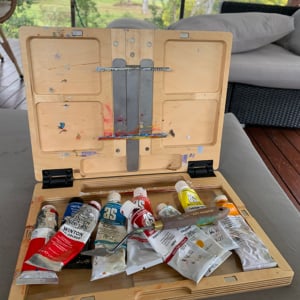What does painting with a limited palette mean? Well essentially, it means limiting the number of colors you use in the painting to the bare essentials.
Painting with a limited palette is touted by many of the great masters, including John Singer Sargent, Anders Zorn and Claude Monet.
Some of the reasons a limited palette may be preferred:
- Color harmony – with fewer colors to mix together in your painting with a limited palette, there is an added harmony between the colors. Alternatively, with a wide array of colors in your palette, this harmony may be stretched out.
- Cost – you will only need to keep a supply of the colors on your limited palette, plus some others for special circumstances (perhaps you need a very vibrant orange which may be difficult to mix yourself). With a limited palette you can also select more common and inexpensive colors to use.
- Simplicity – simplicity is king. Every great master of any craft seems to tout the importance of simplicity. With fewer colors in the mix, you will find it easier to progress through your painting with clarity.
- Knowledge – the best way to learn about color theory and the relationship between colors is to force yourself to mix colors in your palette using just a limited palette.
If you want to paint with a limited palette, then a great place to start is all three primary colors (red, yellow and blue), white, raw umber (or burnt sienna) and black.
Black is optional as you can actually mix a nice black tone by combining equal parts of the primary colors together, or by mixing french ultramarine blue with raw umber. Many great artists, particularly the Impressionists, exclude black from their palette due to the thought it was not a natural color of the environment.
Anders Zorn is thought to have limited his palette to only four colors for many of his paintings: white, yellow ochre, cadmium red medium and ivory black. Ivory black is a cool color and was used by Anders Zorn as a very dark blue.
Want to Learn More?
You might be interested in my Painting Academy course. I’ll walk you through the time-tested fundamentals of painting. It’s perfect for absolute beginner to intermediate painters.
Thanks for Reading!
I appreciate you taking the time to read this post and I hope you found it helpful. Feel free to share it with friends.
Happy painting!
Dan Scott

Draw Paint Academy







Thank you so much
The lesson included good explanations, clearly graded. The examples you added are wonderful. Thoughtful work
Thanks again you are a professional – master teacher